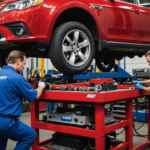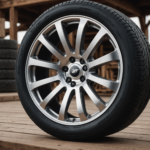Choosing the right tires for a vehicle is pivotal to optimizing its performance, safety, and longevity. Whether embarking on rugged terrain or cruising along smooth highways, understanding the distinctions between off-road and on-road tires will significantly enhance the driving experience. This article delves into the essential factors involved in selecting the appropriate tires for your driving style, offering guidance on the characteristics, benefits, and key differences between off-road and on-road tires.
Understanding the Basics of Tire Types
Tires play a crucial role in vehicle dynamics, affecting acceleration, braking, and cornering. Tires are generally categorized into three primary types:
- Passenger Tires
- Light Truck Tires
- Specialty Tires (including off-road tires)
Key Differences Between Off-Road and On-Road Tires
When selecting tires, understanding the characteristics that differentiate off-road and on-road tires is fundamental. Both types are designed with specific features tailored to their intended environments.
1. Tread Design
The tread pattern is one of the most significant factors in tire performance. Off-road tires typically feature aggressive tread designs to maximize grip on uneven surfaces. These designs include:
- Large, deep tread blocks
- Open voids for better self-cleaning
- Knobby edges for improved traction
Conversely, on-road tires usually have a smoother tread pattern, designed for optimal contact with paved surfaces. This design enhances fuel efficiency and minimizes road noise.
2. Rubber Composition
The rubber compound used in tires varies significantly between types. Off-road tires utilize a more durable rubber compound to withstand abrasion from rough terrains. This increased hardness leads to a longer lifespan on aggressive surfaces but can compromise the overall ride comfort on paved roads.
3. Sidewall Construction
Sidewalls on off-road tires are generally reinforced to resist punctures and impacts from sharp rocks and jagged surfaces. On-road tires have a more flexible sidewall, which enhances ride comfort and handling on smooth roads but may not hold up as well under extreme off-road conditions.
Performances Metrics
Understanding performance metrics is vital in choosing the right tires. Here are some key performance areas to evaluate:
A. Traction
Traction is the ability of a tire to grip the road surface. Off-road tires excel in mud, snow, and rocky conditions, whereas on-road tires perform best in dry and wet conditions on highways.
B. Stability
Stability refers to a tire’s ability to maintain its shape under different loads. On-road tires provide better stability at high speeds, which is crucial for safety when driving on highways.
C. Comfort
On-road tires are designed to provide a smoother ride, reducing vibrations and road noise, enhancing overall comfort. Off-road tires, however, can provide a bumpier experience due to their firmer construction.
Benefits of Off-Road Tires
Selecting off-road tires offers several benefits for those who frequently drive on rough terrain:
- Enhanced Traction: The unique tread patterns allow for better grip on uneven surfaces.
- Improved Durability: Built to withstand harsh conditions, off-road tires usually have a longer lifespan in rugged environments.
- Self-Cleaning Features: Off-road tires are designed to shed mud and debris effectively, maintaining traction.
Benefits of On-Road Tires
On-road tires come with their own advantages, especially for urban drivers:
- Fuel Efficiency: On-road tires are designed to minimize rolling resistance, helping improve fuel economy.
- Ride Comfort: Offer a smoother and quieter ride, essential for long-distance travel.
- Predictable Handling: Designed for stability, these tires provide predictable handling characteristics when navigating highways.
Tire Size Considerations
Understanding tire size is crucial in selecting the right tires for your vehicle. Tire size is usually designated in a format such as P255/70R16, where:
| Measurement | Meaning |
|---|---|
| P | Passenger Vehicle |
| 255 | Section Width in Millimeters |
| 70 | Aspect Ratio (Height/Width) |
| R | Radial Construction |
| 16 | Diameter of the Wheel in Inches |
Choosing the Right Tires for Your Needs
Your choice of tires should align with your driving habits and conditions. Here are some considerations:
1. Assess Your Driving Environment
Evaluate the typical driving conditions. If the majority of driving occurs on highways with minimal off-road use, on-road tires may be appropriate. Conversely, if off-roading is frequent, off-road tires will provide the necessary durability and traction.
2. Consider Seasonal Changes
Seasonality affects tire performance. Winter tires may be beneficial in snowy regions, while all-season or performance tires work better in moderate climates. Off-road enthusiasts may require dedicated mud-terrain tires for wet conditions.
3. Balance Between Comfort and Performance
Determining the right balance between comfort and performance is crucial. On-road tires provide a serene driving experience, whereas off-road tires focus on traction. In certain cases, consider hybrid or all-terrain tires that can handle both environments reasonably well.
Tire Maintenance Tips
Regardless of tire type, regular maintenance is essential for safety and longevity. Here are some tips:
1. Regular Tire Pressure Checks
Maintaining the correct tire pressure enhances fuel efficiency and extends tire life. Check pressures monthly and before long trips.
2. Tire Rotation
Regularly rotating tires helps ensure even wear and prolongs the lifespan. This should typically be done every 5,000 to 7,500 miles.
3. Visual Inspections
Conducting visual inspections for cracks, bulges, or foreign objects can prevent significant issues from developing over time.
Conclusion
Ultimately, the choice between off-road and on-road tires depends on individual driving habits, environmental factors, and vehicle requirements. By understanding the nuances of tire design, performance metrics, and maintenance, drivers can select the most appropriate tires that enhance their driving experience, safety, and vehicle longevity. Investing time in making an informed choice will ensure optimal performance for any driving condition.
FAQs
1. Can I use off-road tires for on-road driving?
While it’s possible, off-road tires may wear out faster on paved surfaces and can cause increased road noise and reduced fuel efficiency.
2. What are all-terrain tires?
All-terrain tires are designed to perform adequately on both on-road and off-road conditions, providing a compromise between traction and comfort.
3. How often should I replace my tires?
The lifespan of tires can vary significantly based on usage, with a general recommendation to replace them every 6 years for optimal safety, even if they appear undamaged.
This article is structured with HTML tags, detailing the nuances between off-road and on-road tire selection, and offers embedded content features including lists, tables, and performance considerations, aiming to engage readers fully while providing valuable information.




















